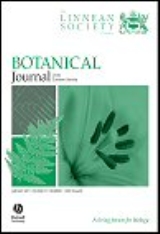
Botanical Journal of the Linnean Society
Encyclopedia
The Botanical Journal of the Linnean Society (Bot. J. Linn. Soc.) is a scientific journal
publishing original papers relating to the taxonomy
of all plant
groups and fungi, including anatomy
, biosystematics, cytology
, ecology
, ethnobotany
, electron microscopy, morphogenesis
, palaeobotany, palynology
and phytochemistry
.
The journal is published by the Linnean Society of London
and is available in both print and searchable online formats.
Like the Biological Journal of the Linnean Society (published since 1858), the journal evolved from the Society's original journal Transactions, which covered early papers by Darwin
and Wallace, becoming an essential, contemporary publication for all those currently working in the field of botany
.
Scientific journal
In academic publishing, a scientific journal is a periodical publication intended to further the progress of science, usually by reporting new research. There are thousands of scientific journals in publication, and many more have been published at various points in the past...
publishing original papers relating to the taxonomy
Taxonomy
Taxonomy is the science of identifying and naming species, and arranging them into a classification. The field of taxonomy, sometimes referred to as "biological taxonomy", revolves around the description and use of taxonomic units, known as taxa...
of all plant
Plant
Plants are living organisms belonging to the kingdom Plantae. Precise definitions of the kingdom vary, but as the term is used here, plants include familiar organisms such as trees, flowers, herbs, bushes, grasses, vines, ferns, mosses, and green algae. The group is also called green plants or...
groups and fungi, including anatomy
Anatomy
Anatomy is a branch of biology and medicine that is the consideration of the structure of living things. It is a general term that includes human anatomy, animal anatomy , and plant anatomy...
, biosystematics, cytology
Cell biology
Cell biology is a scientific discipline that studies cells – their physiological properties, their structure, the organelles they contain, interactions with their environment, their life cycle, division and death. This is done both on a microscopic and molecular level...
, ecology
Ecology
Ecology is the scientific study of the relations that living organisms have with respect to each other and their natural environment. Variables of interest to ecologists include the composition, distribution, amount , number, and changing states of organisms within and among ecosystems...
, ethnobotany
Ethnobotany
Ethnobotany is the scientific study of the relationships that exist between people and plants....
, electron microscopy, morphogenesis
Morphogenesis
Morphogenesis , is the biological process that causes an organism to develop its shape...
, palaeobotany, palynology
Palynology
Palynology is the science that studies contemporary and fossil palynomorphs, including pollen, spores, orbicules, dinoflagellate cysts, acritarchs, chitinozoans and scolecodonts, together with particulate organic matter and kerogen found in sedimentary rocks and sediments...
and phytochemistry
Phytochemistry
Phytochemistry is in the strict sense of the word the study of phytochemicals. These are chemicals derived from plants. In a narrower sense the terms are often used to describe the large number of secondary metabolic compounds found in plants. Many of these are known to provide protection against...
.
The journal is published by the Linnean Society of London
Linnean Society of London
The Linnean Society of London is the world's premier society for the study and dissemination of taxonomy and natural history. It publishes a zoological journal, as well as botanical and biological journals...
and is available in both print and searchable online formats.
Like the Biological Journal of the Linnean Society (published since 1858), the journal evolved from the Society's original journal Transactions, which covered early papers by Darwin
Charles Darwin
Charles Robert Darwin FRS was an English naturalist. He established that all species of life have descended over time from common ancestry, and proposed the scientific theory that this branching pattern of evolution resulted from a process that he called natural selection.He published his theory...
and Wallace, becoming an essential, contemporary publication for all those currently working in the field of botany
Botany
Botany, plant science, or plant biology is a branch of biology that involves the scientific study of plant life. Traditionally, botany also included the study of fungi, algae and viruses...
.

